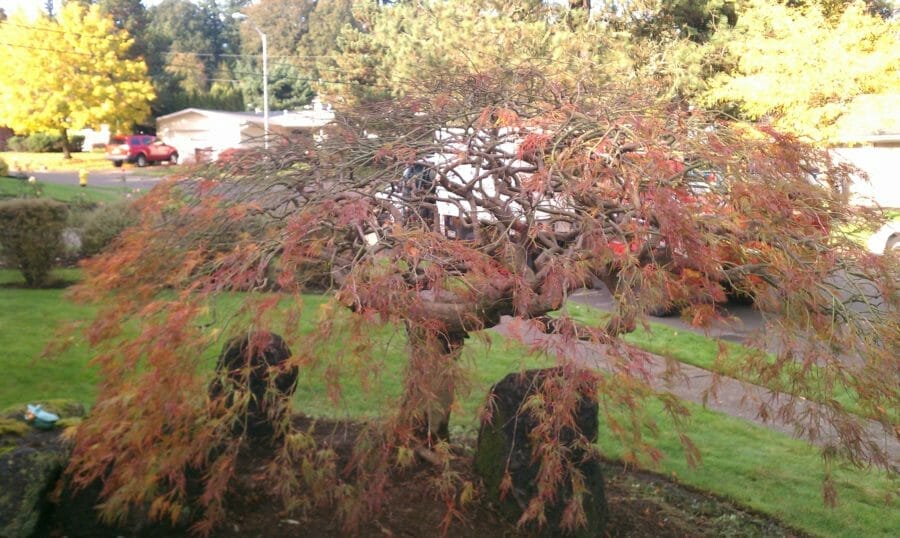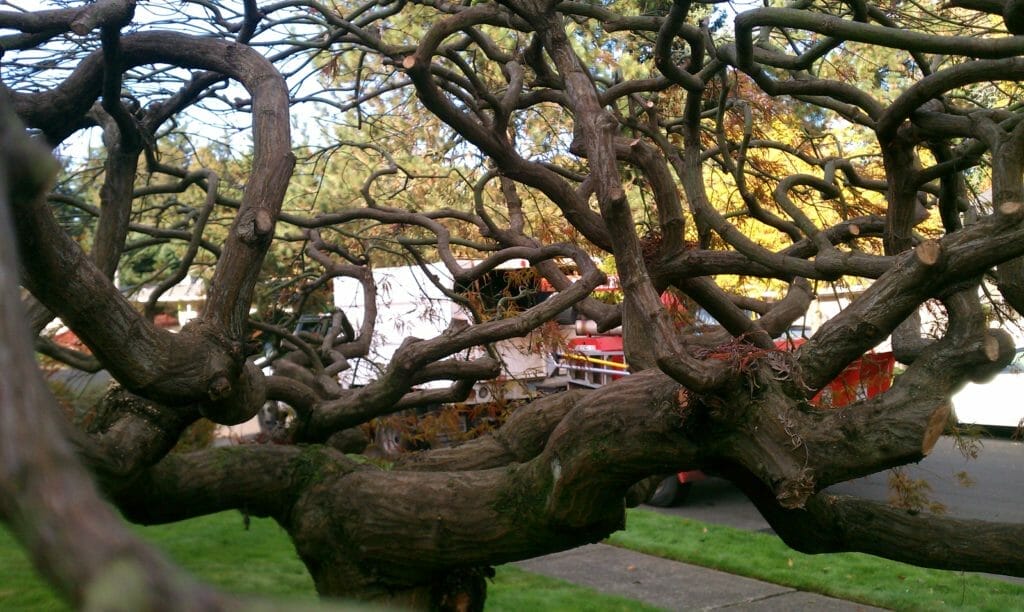Trimming Japanese Maples (Lace Leaf)
TL;DR:
- Pruning Japanese Maples is both an art and a science, requiring expert knowledge to maintain their beauty and health.
- Proper pruning helps direct growth, improve airflow, remove diseased branches, and prevent structural issues.
- The best time to prune is during winter for structural shaping and late spring for fine pruning.
- Key techniques include preserving the canopy, making precise cuts, and avoiding shearing.
- Given the complexity of pruning these delicate trees, professional arborists in Portland, OR, are recommended for the job. For expert care, contact Urban Forest Pro.
 Japanese Maples, also known as Lace Leaf, are some of the most attractive and valuable trees in any garden, so if you are lucky enough to have one on your property, you want to treat it right. When the leaves fall off and the subtle shape of a Japanese maple’s trunk is revealed during the winter months, it can be tempting to get the clippers out and get to work. These trees are among the most difficult and complicated to prune. It takes the skill and talent of a Portland, OR tree pruning service to work with these trees and to shape, define, and encourage their inherently beautiful nature. That’s why we recommend leaving such fine tree care to professional Portland arborists.
Japanese Maples, also known as Lace Leaf, are some of the most attractive and valuable trees in any garden, so if you are lucky enough to have one on your property, you want to treat it right. When the leaves fall off and the subtle shape of a Japanese maple’s trunk is revealed during the winter months, it can be tempting to get the clippers out and get to work. These trees are among the most difficult and complicated to prune. It takes the skill and talent of a Portland, OR tree pruning service to work with these trees and to shape, define, and encourage their inherently beautiful nature. That’s why we recommend leaving such fine tree care to professional Portland arborists.
It has been said that pruning is a science and an art. Pruning is a science because it involves knowledge of plant biology and botany. It is an art because it involves understanding aesthetic beauty. An arborist or horticulturist must understand both aspects in order to be successful with the job at hand. Pruning Japanese maples are no exception. Due to the complex nature of their branching patterns, and their position of great value in the landscape, Japanese maples require expert pruning from the best experienced Portland, Oregon arborists. In this post, our leading arborists discuss why, when, and how to prune Japanese maples. We also explore some of the nuances of aesthetic pruning that are necessary to properly care for these elegant trees.
Why Pruning Japanese Maples is Essential
Pruning Japanese Maple trees is essential for several reasons. The primary reason is that it helps maintain the tree's aesthetic appeal as well as contributes to the tree's overall health and size. Pruning Japanese Maples is a practice that not only enhances their natural beauty but also ensures their vitality and longevity in your garden.
- To direct growth and structure. By pruning, you can direct growth habits and influence the tree's structure as it grows.
- Improve airflow. Increased airflow through branches decreases the likelihood of disease.
- Removal of dead, diseased, or damaged branches. These should always be removed first for the health of the tree.
- Prevent unwanted growth. If a branch is growing into a power line, house eave, or other unwanted areas, it should be removed.
- Reduce weight. If a branch is too heavy, trimming can reduce its weight.
When to Prune Japanese Maple Trees
 The best time to trim most ornamental and fruit trees is during the winter months while they are dormant. For Japanese maples, it is recommended to do structural pruning in the winter and wait until late spring, after the leaves come out, for fine pruning. Summer can also be a good time for removing larger branches and for removing dead, damaged, or diseased wood.
The best time to trim most ornamental and fruit trees is during the winter months while they are dormant. For Japanese maples, it is recommended to do structural pruning in the winter and wait until late spring, after the leaves come out, for fine pruning. Summer can also be a good time for removing larger branches and for removing dead, damaged, or diseased wood.
Know the tree. Spend some time getting to know its structure. What branches need to be pruned? Which branch is the leader or apex branch? Are there competing or crossing branches? What about the overall health of the tree? What is the desired form of the tree? These questions need to be answered in order for your landscape to look its best. Trimming takes time and it will not look good half done. Rather than making a mistake that threatens the life of your Japanese maple, contact our Portland tree pruning service for ongoing expertise and support.
How to Prune a Japanese Maple
Pruning a Japanese Maple is an art form that requires both skill and a keen eye for detail. These exquisite trees are renowned for their delicate, lacy foliage and graceful structure, making them prized additions to any garden. To maintain their health and ensure their beauty, knowing how to prune a Japanese Maple correctly is crucial. This process involves carefully trimming away unwanted growth, dead branches, and excess shoots, while preserving the tree’s symmetrical and elegant form.
To begin, use the proper tools such as shears or pruners to remove any damaged, dead, or overgrown parts of the tree. Thin out areas of the foliage to allow for better airflow and sunlight penetration, which encourages healthy growth. Start by cutting away any sparse or fragile branches that may be limiting the sturdy growth of the tree.
While shaping the tree, focus on maintaining its balance and compact form. Trim shoots and branches that are growing inwards or crossing each other. It’s important to thin the foliage to avoid any dense areas, ensuring that the tree retains its characteristic graceful and well-shaped appearance. Remove any excess growth that may be competing for space or nutrients, which could negatively affect the tree’s overall health.
As you work, take care not to damage the trunk or stem, as this can hinder the tree’s ability to recover. After cutting, always clean your tools to prevent the spread of disease. Pruning at the right time of year, typically in late winter or early spring, is crucial for encouraging new buds and promoting healthy growth.
By carefully snipping and clipping the shoots and branches, you can help your Japanese Maple maintain its elegant, symmetrical shape while promoting a healthy, balanced structure for years to come. With the right pruning techniques, you’ll enhance its natural beauty and ensure that it remains a sturdy, neat, and thriving addition to your garden.
Here are 5 Tips on How To Trim a Japanese Maple
- Remove Dead Branches: Prune to remove dead branches mostly on the interior.
- Preserve Canopy Integrity: Avoid trying to majorly reshape. This will leave unsightly holes in the canopy.
- Steer Clear of Shearing: Refrain from shearing to maintain the tree's characteristic flowing and drooping branches.
- Prune with Precision: Make clean cuts back to lateral branches or buds for optimal results.
- Prevent Disease Spread: Disinfect your tools after each tree to prevent the spread of disease.
Our #1 Tip for Pruning Japanese Maples: Call Us. It takes years of experience to learn how to do a good job trimming a Japanese maple. Extensive training in proper techniques is necessary. In addition to pruning skills, there are other key variables to consider, such as having the proper tools and avoiding the spread of disease and pathogens. Finally, it takes a fair amount of time to do the job right. Call our Portland arborists, your best tree service solution in Oregon, today for the health of your Japanese maples.
Contact Our Japanese Maple Pruning Experts Today
If you have any questions, or concerns about pruning your Japanese Maple tree, our team is here to assist you. Feel free to reach out to us for expert advice, tips, or any inquiries related to the care and maintenance of these elegant trees. Your satisfaction and the well-being of your Japanese Maples are our top priorities. Contact the tree experts near you at Urban Forest Pro by phone at 503-479-5921 or fill out our online contact form and we’ll get back to you.